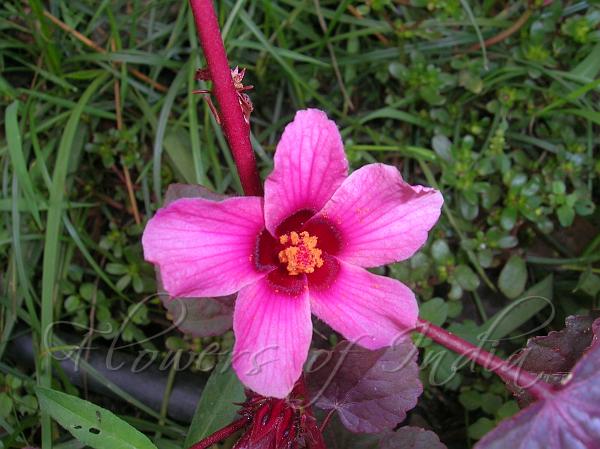|
| Cranberry Hibiscus |
|

|

| File size | 973119 |
| Original date | 3/24/08 10:37 AM |
| Resolution | 2048 x 1536 |
| Flash | Flash fired, auto |
| Focal length | 5.4mm |
| Exposure time | 1/60s |
| Aperture | 4.8 |
| Focus Distance | |
| Metering Mode | Partial |
| Camera make | NIKON |
| Camera model | E3700 |
| Sensor type |
|
|
|
|
Photo: |
Botanical name: Hibiscus acetosella Family: Malvaceae (Mallow family)
Cranberry Hibiscus is an annual to a perennial or
shrubby plant with stems 0.5-2 m tall. It has leaves which vary in
shape from 3-5-lobed to un-lobed or undivided in the upper leaves of
the plant and are generally the size of a small child's hand, about
10×10 cm. They tend to be alternate, simple, and deeply cut with
rounded toothed or jagged edges. Leaf color is a dark maroon to a
patchy red/green. Stipules are linear, about 1.5 cm. Both stems and
leaf-stalks (3-11 cm long) are hairless. Sepals contain 10 veins, 5 of
which run to the apices of the segments; the other 5 run to the
sinuses. Stems tend to be variegated. Flowers are solitary and sit atop
a 1 cm long flower-stalk. They vary in color and are most often the
dark maroon that is characteristic of the foliage with darker vein-like
markings. Flowers are about 5 cm deep. Each flower contains numerous
stamens at about 2 cm in length. The cranberry hibiscus is bisexual and
is thought to be self-pollinating. It produces seeds that are
kidney-shaped and dark brown with dimensions of 3×2.5 mm. Cranberry
Hibiscus is native to Africa, and cultivated in NE India. Leaves - raw
or cooked. An acid flavour with a mucilaginous texture, they can be
added to salads or used in soups, stews etc. They can be cooked with
other foods to give them an acid sorrel-like flavor,
| Identification credit: Daniel L. Levy | Photographed in Imphal, Manipur. |
• Is this flower misidentified? If yes,